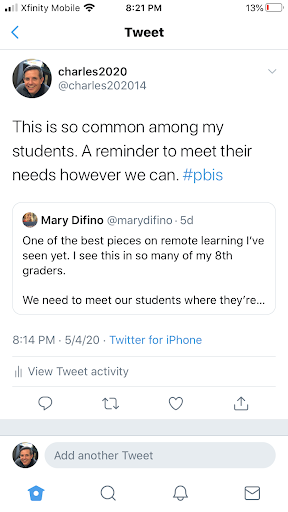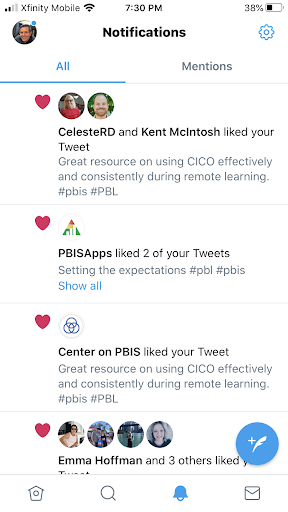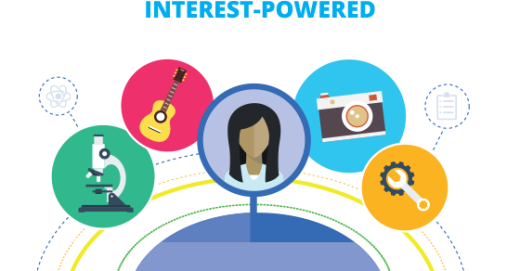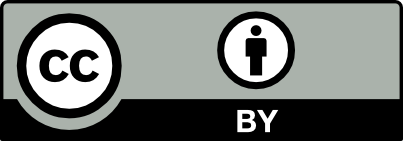I have spent the last 3 months developing my Personal Learning Network (PLN) in the area of Positive Behaviour for Learning (PBL), also known internationally as Positive Behaviour for Intervention Support (PBIS).
The Early Days
Without even realising, my first PLN began with little strategy or effort in the area of Inclusive Education. It was a powerful experience connecting my area of passion from my career to others with more expert knowledge. I wrote my first ever blog for a University Masters class and joined a facebook group with the goal of developing knowledge through engaging and sharing information. Ultimately, I took this knowledge back to the masters program and my place of work.
Elliott (2009), describes a PLN as “ a set of resources, both physical and digital, of your choice, and are used for growth of personal knowledge and skills required to thrive in emerging information environments (p.48). Without thinking too much about it my desire to learn and my own motivation led to a high level of engagement and learning in this topic. After some time I became less engaged in this initial PLN experience as I moved out of the relevant role and into a new area. I also decided to have a technology break and take some time searching for a new role in education.
PLN Coming Together
Beginning this year, I consciously developed and refined my PLN from the broad topic of Inclusive Education to a more specific topic of PBL. Incidentally this coincided with a change in my teaching placement, I knew I was going to be working with more challenging behaviour and at a school that was invested in PBL. Trust (2012) explains “teachers that participate in PLN’s demonstrate what the National Research Council (2000) calls “adaptive expertise” (p.48). Teachers that have adaptive expertise are willing to be flexible and grow with the changes they face” (p.336). My motivation was fuelled by my desire to access relevant information and grow professionally; as the learner I was driven by my own goals rather than the shared goals of the larger group (Oddone, 2018).
My initial mapping of my network included the previously discussed Inclusive Education and strategic PBL/PBIS groups on Facebook and Twitter. Although my initial network was quite limited, I found the information to be credible and regularly updated. Upon reflection, at this point in my PLN I found engagement in the information, but I found I was stuck at the exploratory level in the personal arena of a PLN (Oddone, 2018a). As the term suggests, I was finding and engaging with new relevant information connected to my pedagogy. As Oddone(2018a) explains the Exploratory level as part of the Pedagogical arena, where content knowledge and practice is enhanced, is defined as “staying up to date with implementation of pedagogical and curricular changes” (slide 8). Equally important, I was aware of the need to manage what was developing and the need to attend to it. Liking and retweeting the information is not enough, it takes deliberate filtering, selecting and categorising of the information for your own purpose (Skyring,2017).
I was finding the new experience of twitter to be a powerful learning tool, but also taking a bit of time to get the hang of. I began exploring retweeting with comments and adding relevant hashtags, as I’d learned this creates more exposure because it’s reposted to my profile. My first retweet didn’t get any likes, however I felt I was developing my professional digital literacy by curating and sharing content. Lupton et al.(2019), defines digital literacies as “our comfort, confidence and engagement when using social media and web based technologies as represented by our fluency and understanding of how social technologies and communities operate”.

After a few more tweets things started developing and I received several likes. I began building connections with reliable individuals on twitter, and I started following Shiralle Poed also on Twitter, she is an Associate Professor (QUT) and Principal Fellow (University of Melbourne) who I found through membership with the Association for Positive Behaviour Support Australia (APBSA).

Through facebook I joined the groups APBSA and Positive Behaviour Support Chat and shared a few articles that I had found with a PBL focus. Not a whole of interest was generated, but I felt like it was contributing to my digital literacy.
At this stage of developing my PLN, I reflected upon both my social network identity and my digital literacies. I made a deliberate move to have twitter remain for professional interests. Oddone (2018b), explains that social network identity is related to the authenticity of our identity we project and how different what we project can be on facebook compared to twitter. Digital literacies however, is the comfort, confidence and engagement we display on social media as represented by our understanding and communication. Additionally, In developing my digital professional literacies I evaluated my coherence and interaction, Lupton et al. (2019) describes this as leading, emerging, technical and participatory. I reflected on my emerging behaviours as high coherence with minimal interactions. Moving ahead with my PLN I thought about what steps I could take to move toward the digital professional literacy of leading. I decided on increasing my interactions.
Moving Forward
I began moving forward by setting up a Flipboard curation. I discovered Flipboard as an excellent tool to curate all the great articles I’ve found across all platforms with a central place to store and access them. Basically a huge time saver, and yet another expansion of my PLN, as many others use it to share and highlight information in the PBL space. Likewise, my magazine which I named Positive Behaviour for Learning (PBL), quickly started getting likes and had others viewing the articles, unfortunately though no feedback or discussions.
A major turning point came when I wrote and published a blog on the 10 Essential skills for classroom management applying to remote instruction. I shared it out among my network through my FB groups, added it to my magazine in Flipboard, and tweeted it with several hashtags including those regularly used in my PLN, #pbis, #apbsa, #remoteteaching, #inclusion. I wanted to connect my knowledge with something relevant to the times, so I came up with a connection to remote learning. I feel in hindsight, the timing wasn’t great, particularly as in Australia the announcement that schools were gradually reopening had just been made.
Blog: How the 10 ESCM apply to remote learning
I would never say I’m a good blogger, however I received relevant feedback, several likes and retweets. In reflection, although I had to actively put aside my fears with posting the blog and getting associated, if any, feedback, I felt empowered and confident after sharing it. Despite being potentially daunting, I was hoping for some feedback to actually take away something from the process. This is yet another reason for engaging in PLN’s and I’d set goals of achieving a new learning experience while using new tools. Putting effort into a blog and then not knowing what others think is disheartening, I would never do that to my students as it can be so damaging to learning. The feedback I did receive was strategically worded as supportive and guiding. This supportive approach in learning new skills and sharing specific information is powerful; it’s value is beyond measure (Novak, 2015).
After gaining some confidence and wanting to access some more specific interaction I engaged in my first tweetchat. I searched for PBL/PBIS chats and found #pbischat, however it hadn’t been active since December 2019. I looked into several other popular chats, such as #spedchat (special education chat) & #issedu (Inclusive Education chat), they were based in the USA and they had minimal participants. I managed however, to engage and participate with #aussieEd twitter chat, and I used tweetdeck for the first time. The topic was: Covid 19 Redefining the educational landscape. Despite not taking anything specific away to share with my PLN, I responded to some posed questions and experienced first hand the benefits of connected learning when using this tool, particularly with connections to those members who have expertise (Trust, 2012). In reflection, I wish I had discovered this earlier in my PLN journey, but I plan on connecting further with interest focused twitter chats in the hope to expand my PLN.
Through the Facebook group Positive Behaviour Support Chat, I began interacting by responding to posted questions and sharing my suggestions. Specifically, I engaged with a fellow teacher in NSW who was beginning her PBL journey when schools were shut. I shared some suggestions and thoughts related to her question on Gotchas (token rewards) for online learning. Since this interaction we have shared resources back and forth, engaged in discussion and messaged each other directly with questions and ideas. Along with the blog and this interaction of connected learning, I felt like my Digital Professional Identity was developing nicely with movement towards higher coherence and an increase in interactions (Lupton, et al. 2019).

Image: https://clalliance.org/why-connected-learning/
I have expanded on my original PLN map to show where it is today, and to reflect on the development of my PLN:
When comparing maps it is obvious my PLN has developed through using twitter more effectively and making more connections in ways that I least expected. For example, I didn’t expect Flipboard to be a place where others look at and like articles collected. I also didn’t expect to be linking into Pinterest and youtube. The individual that I connected with through facebook has been a valuable interaction and learning has assisted both of us. After self-assessing where I was part way through this process, I could see where improvement was, and still is needed. Furthermore, I have realized connected educators know they learn best from other educators, who are seeking ideas and solutions to similar challenges you both face (Whitteker, Zoul & Casas, 2015).
Looking to the future
In the near future I need extended time to continue developing my PLN. In doing so, my goal is to develop my digital professional identity at the leading level . I plan on increasing my authentic interactions through valuable contributions in various contexts throughout my PLN. I feel so far, my journey as a connected educator is well on it’s way. Additionally, another benefit I see in expanding my PLN iis in developing meaningful relationships with like minded educators around the world.
While embarking on developing my PLN I primarily wanted to improve my craft and develop my digital literacies. Additionally, I always strongly believed that educators are good at sharing resources, and a PLN certainly advocates a sharing space effectively. The resources that I have already found applicable to my teaching and professional development are numerous, and I endeavour to continue to pay it forward by reposting resources for fellow educators. In this light, I also aim to develop and share blog posts and tip sheets that I have tried and found useful.
In summary, the PLN journey so far has been a great experience. I have tried to put myself out there and I not only developed my skill set in connected learning, but also in PBL. Likewise, I tried to share my knowledge based on my strengths in the form of a blog. It may have been time, or the content itself but it wasn’t overly successful, however I’ve kept the experience in perspective. Whitaker, Zoul & Casas (2015) said it best, “educators are striving to make a greater impact by taking what they receive from their learning network and translating this learning into actionable steps in their own schools or districts” (p. 71)

This work is licensed under a Creative Commons Attribution 4.0 International License
References
Elliott, C,. (2009). We are not alone: the power of Personal Learning Networks. Synergy, 7
(1) pp. 47-50. Retrieved from
http://citeseerx.ist.psu.edu/viewdoc/download?doi=10.1.1.453.7607&rep=rep1&type=pdf
Lupton, M., Oddone, K. & Dreamson, N. (2019). Students’ professional digital identities. In
R. Bridgstock & N. Tippett (Eds.), Higher Education and the Future of Graduate
Employability: A Connectedness Learning Approach. London: Edward Elgar.
Novak, B (2015, July 23). Develop a Personal Learning Network to inspire lifelong learning!
Retrieved from
Oddone, K,. (2018, January 21). PLN’s: Theory and Practice. Retrieved from
https://www.linkinglearning.com.au/plns-theory-and-practice/
Oddone, K (2018, April 29). Transforming Professional Learning with Personal Learning
Networks. Retrieved from
Skyring, C (2017, July 27). Using social media to build your Personal Learning Network.
Retrieved from
https://educationtechnologysolutions.com/2017/07/using-social-media-build-personal-learning-network/
Torrey Trust (2012) Professional Learning Networks Designed for Teacher Learning,
Journal of Digital Learning in Teacher Education, 28:4, 133-138,
DOI: 10.1080/21532974.2012.10784693
Whitaker, T., Zoul, J., & Casas, J. (2015). What connected educators do differently (pp. 1–139).